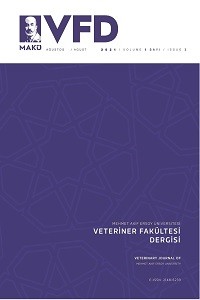Öz
The anatomical features of the rabbit adrenal glands have been investigated in some aspects, either via classic anatomical methods and routine histology, either using imaging modalities in our previous experiments. The present study is focused for obtaining data, concerning the objective values of three macrometric indices – lateromedial, craniocaudal and dorsoventral diameters. We used the cadavers of thirty-four 8-month old (sexually mature) healthy white New Zealand rabbits weighing 2.8-3.2 kg. We reached the abdominal cavity after median incision. The both kidneys were kept in abdominal cavity with a view to find more easily the location of the right and left adrenal glands. The material was documented using a digital camera. The craniocaudal, dorsoventral and lateromedial diameters have been measured using a digital caliper, as the obtained values were accurate to the second sign. Descriptive analysis of the results using Statistica 8 - StatSoft DELL was performed. The lateromedial diameter of the right adrernal gland was 5.1 mm ± 1.0, craniocaudal diameter was 9.3 mm ± 1.2 and the dorsoventral diameter - 5.0 mm ± 0.8. For the left adrenal gland were measured the following values - the lateromedial diameter was 6.5 mm ± 1.2, the craniocaudal diameter was 10. 2 mm ± 1.4 and the dorsoventral diameter was 6.3 mm ± 0.9. Our results showed that the studied parameters of the left gland were with higher values compared to the right gland. The results from the conducted anatomical study deepens the knowledge for the macroscopic features of the rabbit adrenal glands.
Anahtar Kelimeler
Destekleyen Kurum
-
Proje Numarası
-
Teşekkür
-
Kaynakça
- 1. Shiomi M Rabbit as a Model for the Study of Human Diseases. In: Houdebine LM, Fan J (eds.). 49. Rabbit Biotechnology: Rabbit Genomics, Transgenesis, Cloning and Models, Dordrecht: Springer Science + Business Media; 2009. p.49.
- 2. Kigata T, Shibata H. Arterial supply to the rabbit adrenal gland. Anat Sci Int. 2018; 93: 437 – 444.
- 3. Lennox AM, Chitty J Adrenal neoplasia and hyperplasia as a cause of hypertestosteronism in two rabbits, J Exot Pet Med, 2006; 15: 56-58.
- 4. Lennox AM. Surgical treatment of adrenocortical disease. In Harcourt-Brown F and Chitty J (eds). BSAVA Manual of Rabbit Dentistry and Imaging, Gloucester: BSAVA; 2013. p. 269-273.
- 5. Popesko P, Rajtova V, Jorak J. A Colour Atlas of Anatomy of Small Laboratory Animals: Rabbit, the Guinea Pig v.1, Bratislava: Wolfe Publishing; 1992. p. 92.
- 6. Dilek OG, Dimitrov RS, Stamatova-Yovcheva KD, Yovchev DG, Mihaylov R. Importance for experiments in human medicine of imaging modalities for macroanatomical and histological study of rabbit suprarenal glands. Med Weter. 2019; 75: 684-692.
- 7. Harley A, Friend E Adrenal gland. Chapter 35, 393-399 In: Langley-Hobbs S, Demetriou J, Ladlow J, Feline Soft tissue and General Surgery. Elsevier Ltd; 2014. p. 397-399.
- 8. Choi J, Kim H, Yoon J. Ultrasonographic adrenal gland measurements in clinically normal small breed dogs and comparison with pituitary-dependent hyperadrenocorticism. J Vet Med Sci, 2011; 73: 985-989.
- 9. Barthez PY, Nyland TG, Feldman EC Ultrasonographic evaluation of the adrenal glands in dogs. J Am Vet Med Assoc. 1995; 207: 1180-1183.
- 10. Mancinelli E Adrenal glands disease in rabbits. Available at https://www.vettimes.co.uk/app/uploads/wp-post-to-pdf-enhanced-cache/1/adrenal-gland-disease-in-rabbits.pdf. 2016.
Öz
Proje Numarası
-
Kaynakça
- 1. Shiomi M Rabbit as a Model for the Study of Human Diseases. In: Houdebine LM, Fan J (eds.). 49. Rabbit Biotechnology: Rabbit Genomics, Transgenesis, Cloning and Models, Dordrecht: Springer Science + Business Media; 2009. p.49.
- 2. Kigata T, Shibata H. Arterial supply to the rabbit adrenal gland. Anat Sci Int. 2018; 93: 437 – 444.
- 3. Lennox AM, Chitty J Adrenal neoplasia and hyperplasia as a cause of hypertestosteronism in two rabbits, J Exot Pet Med, 2006; 15: 56-58.
- 4. Lennox AM. Surgical treatment of adrenocortical disease. In Harcourt-Brown F and Chitty J (eds). BSAVA Manual of Rabbit Dentistry and Imaging, Gloucester: BSAVA; 2013. p. 269-273.
- 5. Popesko P, Rajtova V, Jorak J. A Colour Atlas of Anatomy of Small Laboratory Animals: Rabbit, the Guinea Pig v.1, Bratislava: Wolfe Publishing; 1992. p. 92.
- 6. Dilek OG, Dimitrov RS, Stamatova-Yovcheva KD, Yovchev DG, Mihaylov R. Importance for experiments in human medicine of imaging modalities for macroanatomical and histological study of rabbit suprarenal glands. Med Weter. 2019; 75: 684-692.
- 7. Harley A, Friend E Adrenal gland. Chapter 35, 393-399 In: Langley-Hobbs S, Demetriou J, Ladlow J, Feline Soft tissue and General Surgery. Elsevier Ltd; 2014. p. 397-399.
- 8. Choi J, Kim H, Yoon J. Ultrasonographic adrenal gland measurements in clinically normal small breed dogs and comparison with pituitary-dependent hyperadrenocorticism. J Vet Med Sci, 2011; 73: 985-989.
- 9. Barthez PY, Nyland TG, Feldman EC Ultrasonographic evaluation of the adrenal glands in dogs. J Am Vet Med Assoc. 1995; 207: 1180-1183.
- 10. Mancinelli E Adrenal glands disease in rabbits. Available at https://www.vettimes.co.uk/app/uploads/wp-post-to-pdf-enhanced-cache/1/adrenal-gland-disease-in-rabbits.pdf. 2016.
Ayrıntılar
| Birincil Dil | İngilizce |
|---|---|
| Konular | Sağlık Kurumları Yönetimi |
| Bölüm | Araştırma Makaleleri |
| Yazarlar | |
| Proje Numarası | - |
| Yayımlanma Tarihi | 31 Ağustos 2021 |
| Gönderilme Tarihi | 23 Nisan 2021 |
| Yayımlandığı Sayı | Yıl 2021 Cilt: 6 Sayı: 2 |



